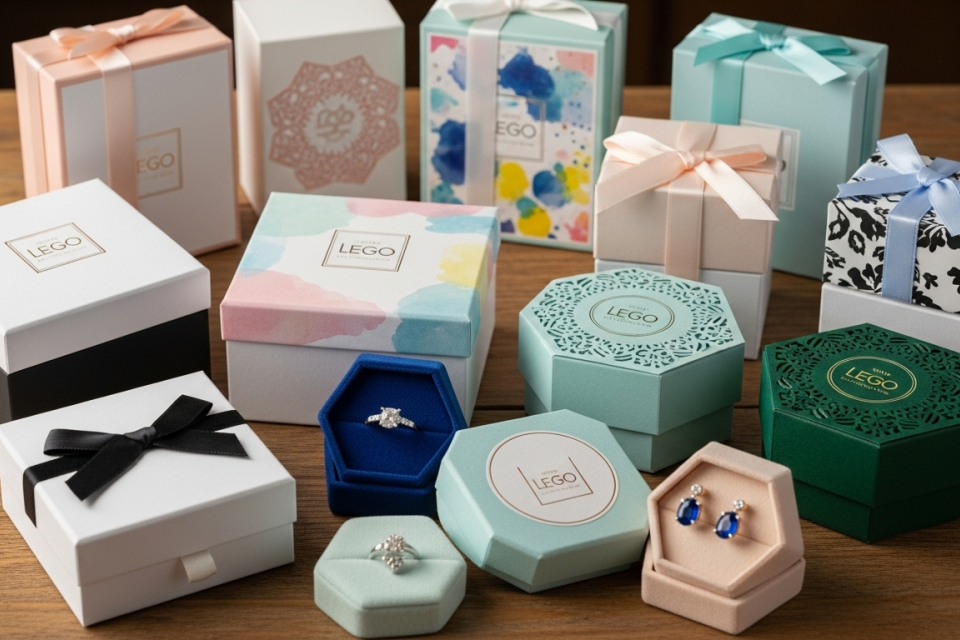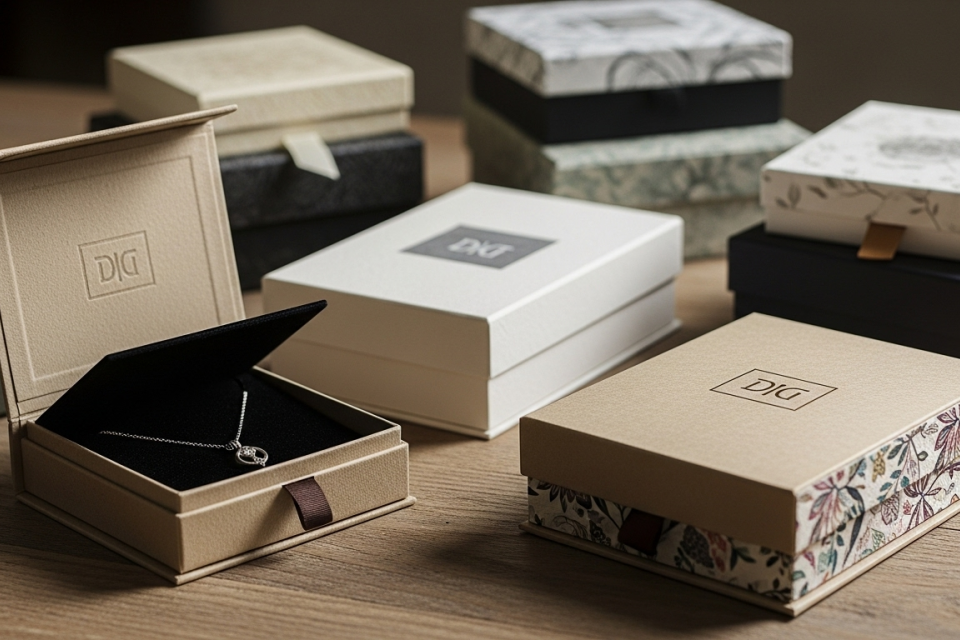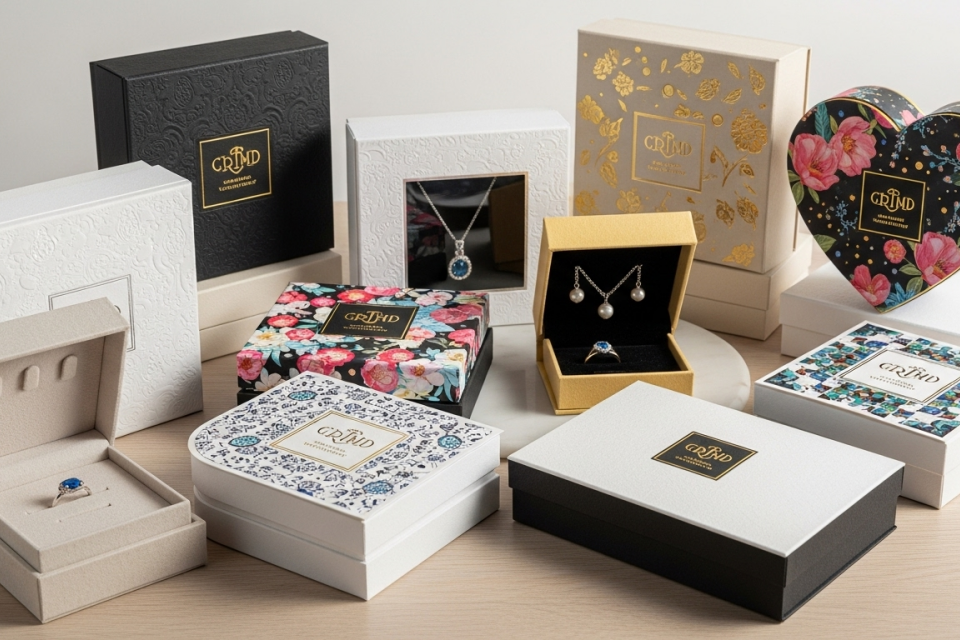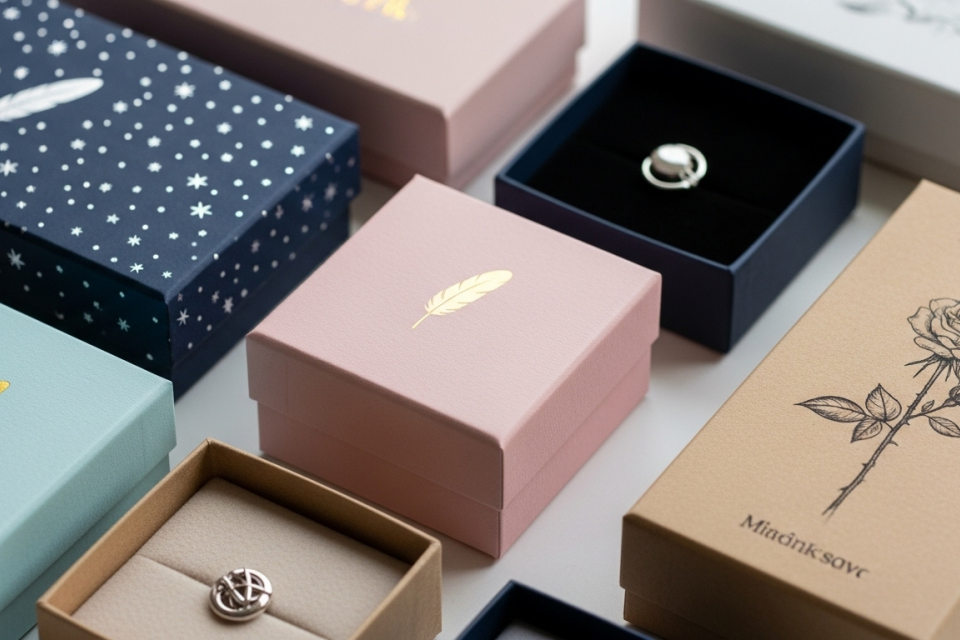Jewelry Box Customization
Discover the rich history and modern trends of jewelry box customization. Explore personalization, sustainable materials, unique designs, and DIY possibilities.
Summary
Jewelry box customization refers to the practice of creating personalized and unique storage solutions for jewelry, allowing individuals to express their identity and enhance the aesthetic appeal of their items. The customization of jewelry boxes has gained significant traction in recent years, reflecting a broader consumer trend towards personalization and meaningful connections with possessions. This evolution is notable not only for its impact on consumer preferences but also for its role in the luxury goods market, where bespoke items are increasingly valued.
Historically, jewelry boxes have served as more than mere storage; they have held cultural and personal significance across various civilizations. From ancient Egypt to modern times, these boxes have evolved in design, materials, and function, often showcasing intricate craftsmanship and artistry. As societies shifted, the artistry behind jewelry boxes transitioned from purely functional objects to luxurious artifacts that signify status and heritage. In contemporary contexts, customization allows for an array of choices regarding materials, design features, and personalization, creating opportunities for emotional engagement between consumers and their purchases.
Prominent trends in jewelry box customization include the use of sustainable materials, innovative design features, and the incorporation of personalized elements such as monogramming and unique shapes. These trends not only cater to the evolving preferences of consumers but also highlight the growing demand for environmentally responsible packaging solutions. Additionally, businesses are increasingly recognizing the importance of creating memorable unboxing experiences that foster brand loyalty and enhance customer satisfaction through tailored designs.
However, this movement towards customization is not without controversy. The push for sustainable practices raises questions about the true environmental impact of materials used in jewelry box production, and the balance between luxury and ecological responsibility remains a critical discussion within the industry. As the market continues to evolve, the discourse around jewelry box customization will likely reflect broader cultural values and consumer expectations regarding personalization, sustainability, and craftsmanship.
Table of Contents
History
Early Origins
Jewelry boxes have a storied history that dates back to ancient civilizations, with the earliest known examples found in Egypt and Mesopotamia around 5000 BC. These early jewelry boxes were crafted from materials such as wood, stone, and metal, and were often elaborately decorated with intricate carvings and inlays. Their primary purpose was to safeguard and store valuable jewelry, which was believed to hold spiritual significance, particularly in ancient Egyptian culture where jewelry was thought to benefit individuals in the afterlife.
Medieval to Renaissance Periods
As time progressed, particularly during the medieval and Renaissance periods, jewelry boxes became more ornate. The craftsmanship evolved, with these boxes often being handcrafted from high-quality woods and adorned with elaborate carvings, inlays, and sometimes even jewels. The Renaissance period saw a shift in design and materials; the boxes were lined with luxurious fabrics and often featured precious metals such as silver and gold, transforming them into valuable display pieces.
18th and 19th Centuries
The 18th and 19th centuries marked a significant change in the accessibility of jewelry boxes. With advancements in craftsmanship and design, these boxes became available in various styles, including Rococo, Baroque, and Victorian. The interiors were typically velvet-lined to protect delicate jewelry, reflecting both aesthetic appeal and functional purpose.
Modern Developments
In contemporary times, the art of jewelry box customization has gained popularity, allowing individuals to express their personal histories and cultural identities through unique designs. Custom-made jewelry boxes often incorporate culturally significant elements and materials, enriching the personal value attached to each piece. As consumers seek more meaningful connections with their belongings, the evolution of jewelry boxes continues to reflect the changing dynamics of culture, history, and personal expression.

Types of Jewelry Box Customization
Jewelry box customization offers various options to enhance both the aesthetic appeal and functionality of the packaging, catering to the specific needs and branding of jewelers. Below are some of the primary customization types available.
Material Choices
High-End Materials
Custom jewelry boxes can be crafted from a selection of luxurious materials such as velvet, suede, and leather, which impart an elegant and sophisticated feel to the packaging. These materials not only enhance the visual appeal but also provide a protective layer for the jewelry inside.
Sustainable Options
For environmentally-conscious brands, sustainable materials such as recycled cardboard and eco-friendly fabrics can be utilized. These options not only minimize the environmental impact but also appeal to consumers looking for responsible choices in their purchases.
Design Features
Unique Shapes and Sizes
Customization allows for the creation of jewelry boxes in various shapes and sizes, tailored to perfectly fit specific jewelry pieces. This bespoke approach not only improves the presentation but also provides added protection.
Advanced Printing Techniques
Utilizing advanced printing techniques, such as UV printing, can create vibrant and high-quality designs on the jewelry boxes. Custom logos, intricate graphics, and unique patterns can significantly enhance brand identity and make a lasting impression on customers.
Decorative Elements
Embossed Logos and Foil Stamps
Adding embossed logos or foil stamps to the jewelry boxes can elevate the luxury feel of the packaging. These decorative elements contribute to a memorable unboxing experience and reinforce brand recognition.
Customizable Accessories
Jewelry boxes can be enhanced with customizable accessories such as ribbons, handles, or metal clasps. These additions not only improve the functionality of the box but also contribute to an overall luxurious experience for the customer.
Interior Customization
Protective Inserts
Incorporating decorative inserts made from silk, foam, or velvet can provide additional protection for the jewelry. These inserts not only cushion delicate pieces but also add to the overall aesthetic appeal of the box.
Lining Options
The interior lining of the jewelry box can be tailored to match the exterior design, with options including satin, organza, or other fabrics that complement the jewelry and enhance the packaging’s luxurious appearance. By utilizing these various types of customization, jewelers can create unique and visually appealing jewelry boxes that not only protect their products but also reflect their brand identity and enhance customer experience.

Popular Trends in Customization
Customization and Personalization
Customization has become a significant trend in the jewelry box industry, driven by consumers’ desire for unique and personalized experiences. Many brands are now offering options for personalization, such as monogramming or engraving, which allow customers to add a personal touch to their jewelry boxes. This trend mirrors successful campaigns in other industries, such as Coca-Cola’s “Share a Coke” initiative, which highlights the power of customization in engaging consumers. As businesses integrate more customization options, they not only meet customer needs but also enhance emotional connections that foster loyalty and repeat business.
Eco-Friendly Customization
With a growing focus on sustainability, many companies are shifting towards eco-friendly packaging materials for customizable jewelry boxes. This includes the use of recycled paper, biodegradable materials, and lightweight designs that reduce shipping costs and carbon footprints. Brands like Patagonia have successfully incorporated recycled materials into their packaging, appealing to environmentally conscious consumers while ensuring customization options remain robust. Such practices not only reduce environmental impact but also position brands as responsible and modern, resonating with the values of today’s consumers.
Minimalist and Ornate Designs
Current trends in customization also reflect a split between minimalist and ornate design preferences. Minimalist designs have gained popularity due to their sleek and stylish appearance, often featuring clean finishes and subtle textures that convey sophistication without being overly flashy. On the other hand, ornate designs appeal to customers looking for luxury and elegance, often incorporating intricate patterns and embossing techniques to create a high-end feel. The choice between these styles is typically based on the brand’s personality and the message they wish to convey through their packaging.
Flexibility and Upselling Opportunities
Offering customizable options not only enhances the customer experience but also opens avenues for upselling. For instance, a customer initially seeking a simple jewelry box may opt for additional features, such as added charms or high-quality materials, when presented with various customization choices. This flexibility allows businesses to adapt their offerings in response to changing consumer trends, ensuring that they remain competitive and relevant in the marketplace.
Unique Shapes and Sizes
In addition to color and pattern customization, unique shapes and sizes are emerging as popular trends. Brands are moving away from standard box shapes to create custom forms that better align with their aesthetic and meet consumer preferences for individuality. This innovation not only enhances the unboxing experience but also positions the jewelry box as an extension of the jewelry itself, making it a part of the overall brand narrative and consumer engagement strategy.

DIY Jewelry Box Customization
Overview
DIY customization of jewelry boxes allows individuals to create unique and personalized packaging solutions that reflect their personal style or brand identity. This process not only enhances the aesthetic appeal of the jewelry box but also adds a layer of sentimental value, making it a perfect gift or display piece.
Materials Needed
To create a custom jewelry box, a variety of materials and tools are required. Essential materials include cardboard, fabric, and high-grade woods, depending on the desired final product. Basic tools necessary for the DIY process consist of a pencil and ruler, X-acto knife, scissors, hot glue gun, and white glue. For more luxurious designs, additional items such as velvet or suede can be utilized to create an elegant finish.
Steps for Customization
1. Designing the Box
The first step in the DIY customization process is to design the jewelry box. This involves sketching out the desired shapes and sizes, taking into account the jewelry pieces that will be stored inside. Custom dimensions can be created to ensure a perfect fit for specific items. The design phase may also include selecting color schemes and incorporating branding elements such as logos or personalized engravings.
2. Material Selection
Once the design is confirmed, selecting appropriate materials is crucial. The choice of materials affects the overall aesthetics and durability of the jewelry box. Options may include wood, metal, glass, or fabric. High-quality materials like velvet, suede, or leather can enhance the luxurious feel of the box, while sustainable options can appeal to eco-conscious consumers.
3. Construction Process
The construction of the jewelry box involves several stages, including cutting and assembling the chosen materials. For wooden boxes, precision cutting tools such as saws or CNC machines may be used to ensure accuracy. After the components are cut, they are assembled using strong adhesives or hardware for durability. Decorative elements such as dividers and inserts can be added to enhance the visual appeal and functionality of the box.
4. Finishing Touches
To complete the customization, finishing touches can be added. This may include decorative elements such as ribbons, handles, or embossing to enhance the unboxing experience. Advanced printing techniques like UV printing can also be utilized to create vibrant, high-quality designs on the surface of the jewelry box. Personalization options such as monogramming or unique engravings can further add a personal touch, making the jewelry box truly one-of-a-kind.

Professional Customization Services
Jewelry box customization services provide a range of options that cater to the unique needs of customers and businesses alike. These services are essential for enhancing the perceived value of jewelry, as they offer personalization that resonates with consumers’ desires for individuality and connection to their purchases.
Customization Options
Many jewelry manufacturers offer extensive customization options that allow clients to create bespoke pieces. This includes not only the jewelry itself but also the packaging in which it is presented. Customization can encompass various elements such as engraving names or special dates on both the jewelry and its accompanying box, creating a sentimental connection to the item. Additionally, businesses can provide unique packaging designs tailored to specific retail needs or seasonal demands, ensuring that the presentation aligns with the brand’s identity and marketing strategy.
Personalization and Engaging Experiences
Engaging consumers through personalized experiences has become increasingly important. By offering features such as custom engraving, unique designs, or personalized notes, companies can create a memorable unboxing experience that deepens customer loyalty. Visual aids, such as design tools or examples of completed projects, can assist customers in navigating the customization process, enhancing their confidence in their design choices.
Quality Control and Craftsmanship
A critical aspect of professional customization services is the quality control processes that ensure each custom order meets the highest standards. Skilled artisans employ traditional techniques alongside modern technology to produce jewelry boxes that not only showcase the beauty of the jewelry but also offer durability and functionality. These craftspeople ensure that each box reflects the brand’s commitment to quality, thereby enhancing the overall consumer experience.
Sustainability Considerations
As sustainability becomes a growing concern among consumers, many jewelry manufacturers are incorporating eco-friendly materials into their customization options. This includes using recycled or sustainably sourced materials for packaging, allowing brands to appeal to environmentally conscious shoppers while providing them with attractive, high-quality products.
Cultural Significance
Jewelry boxes hold profound cultural significance, serving as more than mere storage solutions for precious items. They symbolize personal heritage, societal values, and artistic expression across diverse cultures. The design and craftsmanship of these boxes often reflect the traditions and aesthetic sensibilities of the communities they originate from, bridging the gap between past and present through intricate motifs and symbolism.
Heritage and Tradition
Heritage plays a crucial role in the significance of jewelry boxes. Many cultures have unique customs surrounding the creation and gifting of jewelry boxes, which can encapsulate familial connections and communal traditions. For instance, a jewelry box may serve as an heirloom, passed down through generations, carrying with it the memories and stories of previous owners. Such pieces often symbolize continuity and the bonds of family and heritage, reinforcing personal identities within cultural contexts.
Symbolism in Design
The symbolism embedded in jewelry box designs varies widely among different cultures. Popular motifs often include nature-inspired elements, religious symbols, and traditional patterns that resonate with the community’s values and beliefs. For example, certain designs may feature the Tree of Life, which represents growth and interconnectedness, or tribal patterns that honor ancestral roots. These motifs not only enhance the aesthetic appeal of the jewelry box but also serve as a visual narrative of the cultural heritage they represent.
Status and Spirituality
In various cultures, jewelry boxes are also associated with status and wealth. Historically, ornate jewelry boxes were crafted for the elite, serving as symbols of luxury and social standing. Additionally, many jewelry boxes possess spiritual significance, often designed to hold sacred relics or talismans believed to offer protection or healing properties. In this context, these boxes are viewed as sacred objects that connect individuals to their spiritual beliefs and traditions.
Collectibility and Cultural Appreciation
The rising interest in collecting vintage and antique jewelry boxes reflects a broader appreciation for cultural artifacts and their histories. Enthusiasts often seek out boxes that showcase distinctive styles from different eras, thereby preserving cultural narratives and artistic traditions. As such, these collectible items not only represent personal expression and individual values but also serve as a testament to the rich tapestry of human culture and creativity.
Functionality and Usability
Design Considerations
The functionality of jewelry boxes is paramount, as it directly influences the user experience. High-quality jewelry boxes are designed with compartmentalization as a key feature, providing dedicated spaces for different types of jewelry, such as rings, bracelets, necklaces, and earrings. This organization allows for careful access while minimizing the risk of scratches or damage from pieces rubbing against each other.
Furthermore, the integration of functional designs enhances usability over time. Features such as robust hinges and clasps ensure that the packaging can endure regular use during storage and transit, while removable inserts and adjustable compartments increase versatility, catering to various jewelry styles. This attention to practical functionality not only protects the jewelry but also contributes to a positive customer experience, making them more likely to remember the brand favorably.
Customization Options
Customization is another significant aspect that enhances both functionality and usability. Luxury brands often offer tailored interiors that cater to different types of jewelry, ensuring each item has a designated space. Such custom options provide practical benefits and align with the aesthetic desires of customers, enabling them to express their unique styles through personalized jewelry boxes.
Incorporating design features that allow for easy navigation and organization, such as intuitive layouts and thoughtful dividers, helps create a seamless experience for users. This kind of design encourages long-term use, as customers are more likely to appreciate and retain packaging that meets their specific needs.
Emotional Connection and Brand Experience
The overall design and functionality of jewelry boxes also serve to create an emotional connection between the brand and consumers. Packaging that reflects the brand’s story and values fosters an engaging unboxing experience that resonates with customers on a deeper level. By utilizing high-quality materials and thoughtful craftsmanship, brands can enhance their image while ensuring the usability of their products.
Moreover, sustainable practices in packaging design have become increasingly relevant. Modern consumers are more likely to support brands that reflect their values, including environmental sustainability. Integrating eco-friendly materials and practices not only contributes to the planet’s well-being but also enhances the brand’s appeal, adding an extra layer of value for customers who prioritize sustainability.